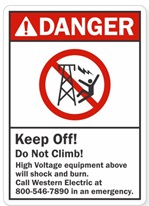Sizing Up OSHA's New Standards for Safety Signs
Will new OSHA standards on safety signs work more effectively?
In September, the OSHA standards on safety signs are scheduled to change. The ANSI Z535 sign design, the committee’s most recent (and detailed) version, will be a sanctioned alternative to OSHA's traditional, straightforward template.
The traditional OSHA sign designs, as depicted above, follow ANSI 35.1 (from 1968).
 The ANSI Z535 safety sign design is shown at left.
The ANSI Z535 safety sign design is shown at left.
The ANSI Z535 designs, currently used primarily with custom-designed warning signs, are nuanced; they better reflect and address the complicated hazards of the modern workplace, such as illiteracy, high turnover, and hazards with hidden or delayed impact.
The designs give employers another good option to consider as they safeguard their employees.
Downsides of Incorporating ANSI Z35 Designs Within the OSHA Rules
Still, for all their updated advantages, the Z535 designs, in many situations, are not better. The Z535 designs require, in most situations, more information. By putting more information on the sign, I worry that there will be a subtle downgrading of training. Why train when the proper handling instructions are given on the sign itself?
Additionally, information can go stale. A sign that says "call x808 In Case of an Emergency" or "Wear Latex Gloves," while better in the short term, can quickly become a hazard itself. Safety officers change. New research can emerge on proper PPE to wear. In contrast, a "Danger Keep Out" sign is evergreen. Eventually, many environments will have a mishmash of both traditional and Z535 designs -– with some accurate and others misleading.
Part of the ANSI design's limitation is that it was created by committee. Driven by stakeholders in the warning industry (think label designers for equipment, symbol researchers, consultants who feed off tort litigation), the ANSI standards sometimes support the needs of the label market over the practical needs of safety signs. Trying to harmonize safety label designs with safety sign designs has caused many problems.
In the Z535 designs, hazard and probability distinctions are lost on all but the most sophisticated users. The designer – and, importantly, the passerby potentially affected by a hazard -– must make a series of very complicated probability and risk assessment choices. Fine distinctions must be quickly made between different types of injuries and the probability of an accident. Lawyers love it, but I'm worried about the naïve layman. You shouldn't have to be a lawyer or a graphic designer to create a new safety sign, let alone read one. There is no time to decipher a severity and probability flow chart when face to face with a hazard.
Little research has been done to prove that the ANSI Z535 designs, as a system, are significantly superior to other safety sign designs. Yes, symbols and legibility research has been done. The benefits of adding hazard avoidance information on signs are hard to dispute. Still, little critical work exists on the Z535 sign design as a whole. What research does exist is worrying, throwing into doubt the effectiveness of the "Warning" header.
How Will Safety Signs Change if the OSHA Update is Accepted?
In many ways, I applaud the changes of the ANSI Z535 standard. After all, I helped draft many of the changes that were incorporated in the safety sign, as well as the safety tag standards.
Safety signs, most of all, are advertisements for safe behavior. Like any good advertising campaign from Madison Avenue, it is hard to construct a single design standard that is good for all safety signs. Safety sign designers need a wide range of motivational tools, slogans, and designs to prevent accidents -– depending upon the audience, their training, and the urgency of the hazard.
It would be arrogant to assume that a single standard is best. The ANSI Z535 designs, the traditional safety sign and tag designs, as well as the countless other designs to come, will all have their place and will all coexist.
This is not only inevitable, but also good for safety.
To see a more extensive article, visit here.
Blair Brewster is president of www.MySafetySign.com and is a past member of the ANSI Z535 committee. During the past 30 years, he has founded and built companies that manufacture, distribute, and design safety signs.
Posted by Blair Brewster on Jul 25, 2013